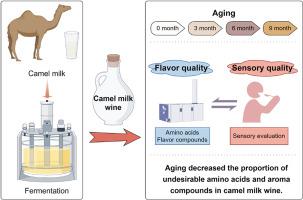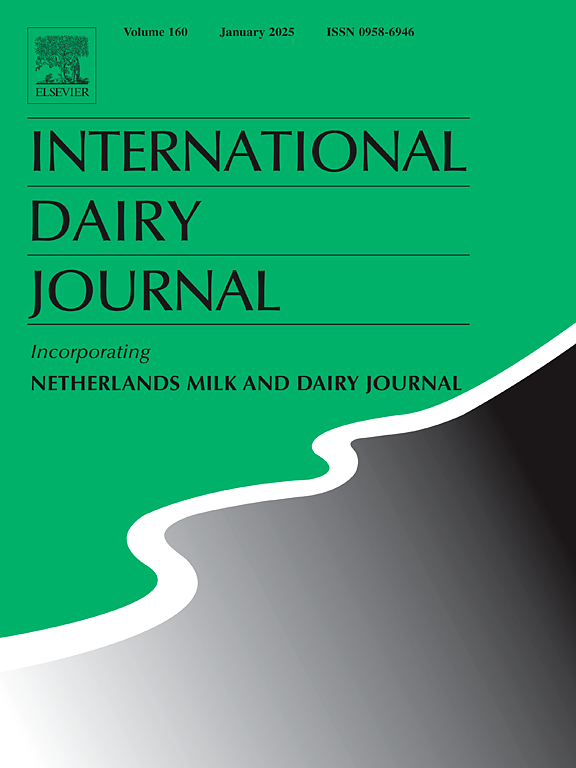陈酿对骆驼奶酒风味成分及感官品质的影响
IF 3.4
3区 农林科学
Q2 FOOD SCIENCE & TECHNOLOGY
引用次数: 0
摘要
研究了驼奶酒在0 ~ 9个月的陈酿过程中理化性质、挥发性风味物质、游离氨基酸、感官特性和微生物安全性的动态变化。衰老导致颜色逐渐变黄,酯类化合物显著增加,同时醇类、酸类、醛类和酮类化合物减少。产生甜味和鲜味的氨基酸——如谷氨酸、Ala和ser——随着时间的推移而增加,而苦味的氨基酸则减少。PLSR分析显示,良好的感官属性与甜/鲜味氨基酸和酯类呈正相关,苦味氨基酸和酸类与感官品质呈负相关。微生物学评估证实,在整个老化过程中没有常见的致病菌,表明微生物稳定性良好。总的来说,陈酿通过调节骆驼奶酒中不需要的氨基酸和香气化合物,提高了骆驼奶酒的风味复杂性和感官接受度。研究结果为开发高品质驼奶产品优化老化策略提供了科学依据。本文章由计算机程序翻译,如有差异,请以英文原文为准。

Impact of aging on the flavor composition and sensory quality in camel milk wine
This study investigated the dynamic changes in physicochemical properties, volatile flavor compounds, free amino acids, sensory attributes, and microbial safety of camel milk wine during 0–9 months of aging. Aging led to a gradual color shift toward yellow and a significant increase in ester compounds, accompanied by reductions in alcohols, acids, aldehydes, and ketones. Amino acids contributing to sweetness and umami-such as Glu, Ala, and Ser-increased over time, while bitter-tasting amino acids decreased. PLSR analysis revealed positive correlations between favorable sensory attributes and sweet/umami amino acids and esters, while bitter amino acids and acids were negatively associated with sensory quality. Microbiological assessment confirmed the absence of common pathogenic bacteria throughout the aging process, indicating good microbial stability. Overall, aging improved the flavor complexity and sensory acceptability of camel milk wine by modulating its undesirable amino acids and aroma compounds. These findings provide a scientific basis for optimizing aging strategies in the development of high-quality camel milk products.
求助全文
通过发布文献求助,成功后即可免费获取论文全文。
去求助
来源期刊

International Dairy Journal
工程技术-食品科技
CiteScore
6.50
自引率
9.70%
发文量
200
审稿时长
49 days
期刊介绍:
The International Dairy Journal publishes significant advancements in dairy science and technology in the form of research articles and critical reviews that are of relevance to the broader international dairy community. Within this scope, research on the science and technology of milk and dairy products and the nutritional and health aspects of dairy foods are included; the journal pays particular attention to applied research and its interface with the dairy industry.
The journal''s coverage includes the following, where directly applicable to dairy science and technology:
• Chemistry and physico-chemical properties of milk constituents
• Microbiology, food safety, enzymology, biotechnology
• Processing and engineering
• Emulsion science, food structure, and texture
• Raw material quality and effect on relevant products
• Flavour and off-flavour development
• Technological functionality and applications of dairy ingredients
• Sensory and consumer sciences
• Nutrition and substantiation of human health implications of milk components or dairy products
International Dairy Journal does not publish papers related to milk production, animal health and other aspects of on-farm milk production unless there is a clear relationship to dairy technology, human health or final product quality.
 求助内容:
求助内容: 应助结果提醒方式:
应助结果提醒方式:


